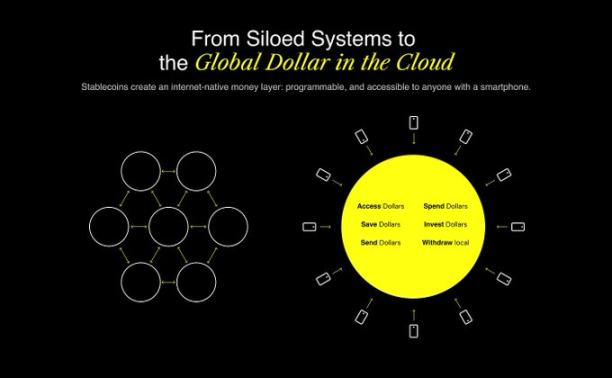Infrastructure provides possibilities, user experience wins everything.
Written by: Ignas Survila
Translated by: AididiaoJP, Foresight News
Currency is experiencing its own "internet moment."
The internet has long had communication systems (email), publishing platforms (blogs, social media), and commercial systems (Stripe, Shopify). Now, it is building its own financial system. This system is inherently programmable, open by default, and borderless from day one. It is being built on the underlying protocols of stablecoins.
But the key is: despite the rise of infrastructure, we still lack critical user experience. History tells us that it is here where the biggest winners are crowned.

Infrastructure provides possibilities, user experience wins everything
Every cool technological revolution begins with infrastructure, but no one remembers the protocols; everyone remembers the products that made it usable.
In 1982, the Simple Mail Transfer Protocol (SMTP) made email possible. However, it wasn't until 2004, when Gmail launched with its clean product, massive storage, and effective spam filters, that email truly became mainstream.
Search engines existed long before Google. AltaVista, Archie, Lycos. But Google simplified everything; it was faster, cleaner, and smarter.
Skype did not invent Voice over Internet Protocol (VoIP), and WhatsApp did not invent instant messaging, but they made these technologies accessible to the average person.
We are at the same inflection point in the development of currency
Stablecoins are helping to create an internet-native financial system.
And this is not theoretical; it is already in operation.
In 2024, stablecoins settled over $15.6 trillion on-chain.
Tether is now the 18th largest holder of U.S. Treasury bonds globally, surpassing countries like South Korea, the UAE, and even Germany. From another perspective, the world's fourth-largest economy now holds less U.S. debt than a single stablecoin issuer.
However, despite this scale, the circulating supply of stablecoins is only $263 billion, compared to the U.S. M2 money supply of $22 trillion, with a penetration rate barely reaching 1%.
Today, less than 5% of the global population uses stablecoins, but it is expected that in the next five years, adoption will reach 7-10%, unleashing a massive new wave of financial inclusivity.
In regions like Latin America, the Middle East and North Africa, and Southeast Asia, stablecoins are already operating as parallel dollar economies, with people relying on them daily to escape inflation, capital controls, or failures of local banking systems.

We have never seen financial infrastructure expand so rapidly, especially cross-border. Stablecoins have reached millions of users worldwide. There is ample reason for this: they are fast, borderless, dollar-denominated, and operate on open protocols. In a world where 1.4 billion people lack adequate financial services, and even more are constrained by capital controls or volatile local currencies, stablecoins offer something revolutionary: an interface to access the global dollar network, accessible from anywhere with just a smartphone.

But the problem is: if you try to use stablecoins today, you will quickly hit a wall. The payment experience is clunky, the onboarding process is confusing, and everything is wrapped in jargon, wallets, gas fees, networks, and cross-chain bridges.
This is where the gap lies; we have a new currency operating system called internet-native financial cloud, but most people still cannot access it.
It's like receiving a PS2 steering wheel for Christmas without having a PlayStation to connect it to. A huge opportunity lies ahead: to make all of this feel normal, intangible, and seamless.
Why user experience is the moat
In the fintech space, having users means having user relationships. Trust is built here, user behavior is shaped here, and long-term value is created here.
While user experience is rarely the most compelling argument in strategic meetings, in fintech, it is everything. Because this is not just software; this is money. And money requires trust.
Just look at the most successful cases in the neobanking sector: Revolut, Cash App, Nubank. These companies operate in different markets, but they all follow the same strategy: providing a world-class user experience.
As stablecoins enter their next phase of adoption, the real winners will be the brands that people trust when sending money to family, the cards they instinctively use to pay for lunch, and the apps that quietly replace their local banks. It will be the kind of experience that makes stablecoins feel intangible, making them feel like regular currency. Ordinary, but universally applicable.

Why now?
What makes this moment so urgent and exciting is the combination of three forces:
Infrastructure is ready
Stablecoins are liquid and are being deeply integrated.
Wallet-as-a-service platforms (like Privy) and embedded deposit channels (like Bridge) are solving the technical user experience challenges.
Credit card issuance, compliance-as-a-service, and KYC providers, all of which have been battle-tested.
Regulation is catching up
Hong Kong is launching legislation for stablecoins in 2024.
The U.S. Treasury's GENIUS Act outlines a future path for regulated, scalable stablecoin use.
User base is rapidly growing
In Latin America and Sub-Saharan Africa, stablecoins are leapfrogging traditional banking.
Globally, 1.4 billion people still lack adequate financial services. But they have smartphones.
Generation Z is inherently the native population of internet finance.
This is not a speculative hype cycle. This is the maturation of infrastructure, regulation paving the way, and a massive consumer market waiting to be served. Billions of people still lack access to modern financial tools and services, but they have smartphones, internet access, and are becoming increasingly familiar with stablecoins. The underlying protocols are finally in place. Now it is a race to build that experience layer that brings everything to life.

The standard for stablecoins is being written
We believe that the most underestimated initiative in fintech today is to build a stablecoin experience that feels like Apple Pay, including a background-integrated experience, a usable experience, and a winning experience that is obvious, trustworthy, and globally applicable.
免责声明:本文章仅代表作者个人观点,不代表本平台的立场和观点。本文章仅供信息分享,不构成对任何人的任何投资建议。用户与作者之间的任何争议,与本平台无关。如网页中刊载的文章或图片涉及侵权,请提供相关的权利证明和身份证明发送邮件到support@aicoin.com,本平台相关工作人员将会进行核查。




